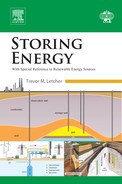Vanadium Redox Flow Batteries
Abstract
A redox flow battery (RFB) is a special type of electrochemical storage device. Electric energy is stored in electrolytes which are in the form of bulk fluids stored in two vessels. Power conversion is realized in a stack, made of electrodes, membranes, and bipolar plates. In contrast to conventional lead–acid or lithium-ion batteries, the energy conversion unit and energy storage unit are separate devices. From this point of view RFBs are more like reversible fuel cells in that the stack is the power conversion unit and is built in a filter press design; or, compared with other storage technologies, like pumped hydro systems, where power conversion is realized by pumps and turbines, but capacity by higher and lower elevation reservoirs. This advantage leads to applications where higher or various ratios of capacity to power (kilowatt-hours per kilowatt) are needed or advantageous—usual are ratios from 5:1 to 10:1. The most common and mature RFB is the vanadium redox flow battery (VRFB) with vanadium as both catholyte (V2+, V3+) and anolyte (V4+, V5+). No cross-contamination from anolyte to catholyte is possible and hence this is one of the most simple electrolyte systems known. Other electrolyte systems could be cheaper (Fe/Cr) or more efficient, but currently these are not available. Other important advantages of the VRFB include long-lasting operation time, long lifecycle; good stability; ease of regeneration or recycling of the electrolyte; and very low flammability. Disadvantages include low energy density both gravimetric and volumetric so that mobile applications are excluded, and currently they are relatively expensive when compared to lead–acid or lithium-ion batteries. Their higher cost is largely due to lower maturity and thus they do not have the advantage that mass production would bring about.
Keywords
1. Introduction and historic development



2. The function of the VRFB


3. Electrolytes of VRFB
 (12.3)
(12.3)4. VRFB versus other battery types
Table 12.1
Main Specs of VRFB Compared with Other Battery Types [17]
| Battery type | Cycle lifetime (cycles) | Energy efficiency/(%) | CAPEX/ [€ (kW h)–1] | Status |
| VRFB | 20 000 | 70–85 | 500–650 | Under development; near to market launch |
| Lead–acid | 300–2 000 | 75–90 | 300–600 | Commercial |
| NiCd | 1 000 | 60–65 | – | Commercial |
| NiMh | 1 400 | 70 | – | Commercial |
| Li-Ion | 500–15 000 | 90–95 | 1 000–1 500 | Commercial (consumer size), demonstration (huge, stationary) |
| NaS (high temperature) | 3 000–7 000 | 70–85 | 130–230 | Commercial |
| Zn–air | 500 | 60–70 | 250–300 | Under development |

5. Application of VRFB
Table 12.2
Assessment of Redox Flow and Batteries and Other Storage Devices Matched with Different Battery Properties
| Application | Redox flow | Lead–acid | Sodium–sulfur | Lithium–ion | Supercapacitor |
| (1) Time shift | + | + | + | + | – |
| (2) Renewable integration | + | + | + | + | – |
| (3) Network investment deferral | + | ± | + | + | – |
| (4) Primary control power | + | + | + | + | – |
| (5) Secondary control power | + | + | + | + | – |
| (6) Tertiary control power | + | + | + | + | – |
| (7) Power system startup | ± | + | + | + | – |
| (8) Voltage support | ± | + | + | + | + |
| (9) Power quality | ± | ± | ± | ± | + |

5.1. Applications
5.2. Current Large-Scale Applications


Here HH and MM refer to hours and minutes, respectively. (Data from Sandia [24].)

6. Recycling, environment, safety, and availability

7. Other flow batteries
Table 12.3
Most Investigated Flow Batteries
| System type/active material | Cell voltage/V | Chemistry | Electrolyte |
| Redox flow | Anode/cathode | Anode/cathode | |
| Vanadium VRB | 1.4 | V2+/VO2+ | H2SO4/H2SO4 |
| Vanadium–bromine | 1.3 | V2+/1/2Br2 | VCl3/NaBr (HCl) |
| Polysulfide–bromine PSB | 1.5 | 2S22–/Br2 | NaS2/NaBr (NaOH) |
| Iron–chromium | 1.2 | Fe2+/Cr3+ | HCl/HCl |
| Hydrogen–bromine | 1.1 | H2/Br2 | NaBr (NaOH) |
| Hybrid flow | Anode/cathode | Anode/cathode | |
| Zinc–bromine | 1.8 | Zn/Br2 | Zn/ZnBr2 (NaOH) |
| Zinc–cerium | 2.4 | Zn/2Ce4+ | CH3SO3H/CH3SO3H |

7.1. Iron–Chromium Flow Battery
7.2. Polysulfide Bromine Flow Battery

7.3. All-Organic Redox Flow Battery
7.4. Hybrid Flow Batteries
7.4.1. Zinc–Bromine Flow Battery
7.4.2. Zinc–Cerium Flow Battery
7.4.3. Iron/Iron Flow Battery

